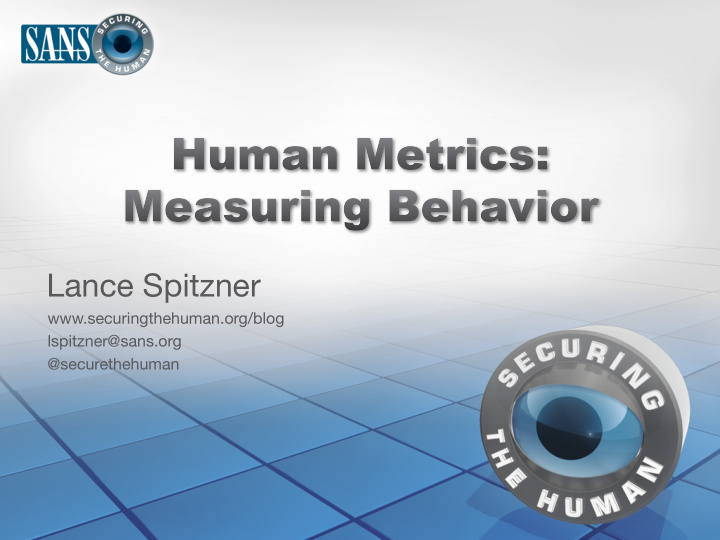



Lance Spitzner www.securingthehuman.org/blog lspitzner@sans.org @securethehuman
Security ¡Awareness ¡ Maturity ¡Model ¡ Metrics Framework Long Term Sustainment & Culture Change Promoting Awareness & Behavior Change Compliance Focused Non-Existent
Useful Metrics • Focus on just a few, high value metrics (a metric that measures a human risk or behavior that you care about). • A metric is a measurement, it does not have value unless you can understand, analyze and act on it. • Just need to be better then what you had before.
2 Types of Awareness Metrics 1. Metrics that measure the deployment of your awareness program. - Are you compliant? 2. Metrics that measure the impact of your awareness program. – Are you changing behavior?
Example Metric - Phishing Recreate the very same attacks that the bad guys are launching. Excellent way to measure human risk and the mitigation of that risk (change in behavior). – Measures a top human risk – Simple, low cost and easy to automate – Easy to analyze – Actionable
Key Points • Computers do not have feelings, people do. Remembering this is key for any human metrics program. • Announce and explain your metrics program ahead of time. • Start simple, do not try to fail or trick people. • Do not publicly post names of people who fall victim nor embarrass anyone. • Only give names to management of repeat offenders.
Get Approval • Before conducting any type of assessment, make sure you have approval. • Can’t get approval, try a test run against the blockers (HR, Legal) • Make sure security team knows ahead of time, let them know each time when you do it and whom to contact when things go wrong
How Many to Assess? • Most metrics use a statistical sampling, you may not the have time or resources to test everyone • Take lessons learned from sample and apply to whole organization www.surveysystem.com/sscalc.htm
Starting Simple
Feedback? If a person falls victim to an assessment you have two options – No feedback / error message – Immediate feedback that explains this was a test, what they did wrong and how to protect themselves
Follow-up • Send results of test to all employees 24 hours later. • Explain results and how they could have detected phishing email and what to look for in the future. Include image of phishing email. • Include your monthly security awareness newsletter.
Repeat Offenders • First violation, employee is notified with additional or follow-on training. • Second violation, employee is notified and manager is copied. • Third violation, manager is required to have meeting with employee and report results to security. • Fourth violation, employee reported to HR.
The Impact • First phish: 30-60% fall victim. • 6-12 months later: Low as 5%. • The more often the assessments, the more effective the impact. – Quarterly: 19% – Every other month: 12% – Monthly: 05% • Over time you will most likely have to increase difficulty of tests.
Human Sensors • Another valuable metric is how many reported the attack. • At some point, may need to develop a policy on what to report. On example. – Do not report when you know you have a phish, simple delete. – Report if you don’t know (think APT) – Report if you fell victim.
Are People Updating Devices?
Physical Security Behaviors • See if unauthorized person can enter or walk around facilities without an ID badge • Check desktops to make sure computer screens are locked and there is no sensitive information left on desks • Check parked cars for mobile devices left in open
Human Vulnerability Scanner • Sometimes the simplest way to measure a behavior is simply ask • Survey can measure behaviors that you normally do not have access to • Think of the human risk survey as the human vulnerability scanner
Data May Already Be There • There may not be a need to collect data as you already have the data. Check with – Security Operations Center – Incident Response Team – Help Desk – Human Resources • Example: Number of infected computers per month.
Summary Metrics are powerful way to both measure and reinforce your awareness program. securingthehuman.org/r securingthehuman.org/resour esources ces sans.org/mgt433
Recommend
More recommend